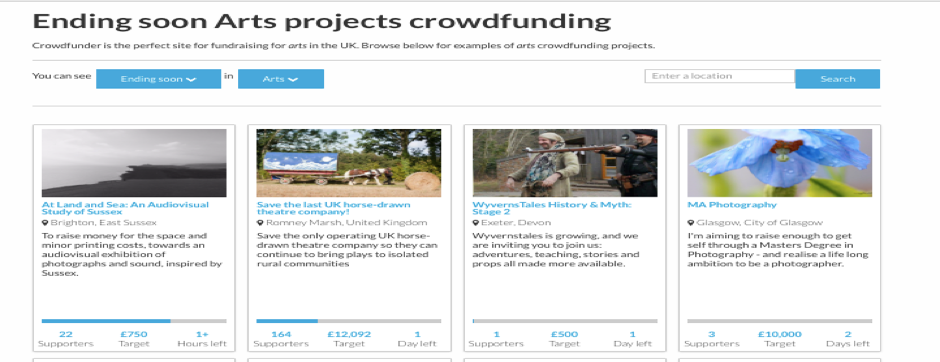Third blog in the series of arts & culture fundraising Myths (#5Myths) by Bernard Ross. This time, crowdfunding…
The headlines and hashtags leap out – mostly from social media, and especially Twitter – with claims that crowdfunding will replace or massively supplant ‘conventional’ fundraising.
These headlines and claims offer hope, often to small organisations, about the coming ‘democratisation of funding.’ Not surprisingly many of these claims are made by agencies who are themselves crowdfunding sites eagerly seeking a share of what is undoubtedly a fast growing and attractive market.
Just to be clear, it has been nearly 20 years since the first online gifts began flowing to non-profit organisations. In that time, online giving has indeed grown tremendously. Well I say tremendously, but I may be using the word in the way that Donald Trump uses it. Non-profits generally – there are no reliable smaller arts and culture figures – need to consider that less than 10% of all giving happens online in the UK and about the same in the US. Moreover, lots of that online giving is actually fulfilment for offline appeals. (So I regularly complete my own donations to causes by credit card online, but I’m actually asked to give on TV, on radio, and by direct mail as well as through online banner ads and emails. So that 10% is probably an overstatement of real online giving.)

Part of the confusion about the scale of giving is because charity online giving is often mixed up with crowdfunding which includes all the money that is invested in commercial products and services, for example on KickStarter. Most of these funds are simply commercial products that people buy upfront. Charity crowdfunding includes direct crowdfunding where agencies such as the British Red Cross ask for contributions towards an appeal like that for the Manchester bomb or Grenfell Fire victims. These can raise many millions, backed by publicity in conventional media. But it also includes peer-to-peer fundraising where individuals ask their friends, family and associates to contribute to an activity they’re doing. The average campaign here raises around £500.
There are specialist arts fundraising sites, but quite a number like www.wedidthis.com and www.sponsume.com have gone bust or been taken over in recent years. Other sites like Crowdfunder have specialist arts and culture sections. For example, http://www.crowdfunder.co.uk/projects/search/category:arts It’s tempting to look just at the home page with what looks like some potentially successful projects. But notice the default view promoted in the top left corner – ‘view by most funded.’ Surprise, surprise, this is a page of most successful projects.

Now take a minute to scroll though some of the other views. Have a look at ‘ending soon’ where most of the projects have failed to reach their target.

There’s no reliable source of data on results overall, but again my dataset of 000s of customers who’ve tried crowdfunding, tells me that only around 40% of projects succeed. And mostly the smaller £500 ones. Some fail because they don’t tell an inspiring story. Some fail because they are way too ambitious. But most fail, I think, because of a fundamental challenge summed up by a respected commentator on things digital – and great online fundraiser – Paul de Gregorio of Open, “Crowdfunding needs a crowd.” In other words, unless you already have supporters that you can drive to the site and who want to share their commitment with their friends, you’re on a hiding to nothing. Don’t try to start a supporter relationship by asking for money.
Key learning from the myth
The reality is that charity crowdfunding is a relatively small part of fundraising overall. It
tends to be most effective when:
- relatively small sums are sought
- the cause is emotive
- media support at a local or national level means it’s high-profile
- you have an established network or have the means to build one
The greatest use for crowdfunding in the general charity world is to recruit supporters that you then begin a long-term relationship with. Sadly, lots of arts and culture fundraisers treat it like a transaction. A unicorn is for life, not just for Christmas…
What’s next?
- Read the 4th myth
- Go back to the 2nd myth
- Find out how the National Arts Fundraising School differs from other arts & culture fundraising training and impacts on your whole career.
- Contact us to speak to one of our fundraising experts about a particular challenge you’re facing.




